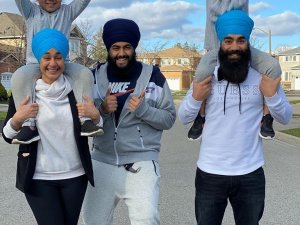“What is the Kaur’s physical identity? Do we have a universal “look”? What is (or should be) the Kaur image?” Many Sikh women thought about these questions, to different degrees and depths, at some point in their lives. It can be a challenging journey without clear answers. Here, we explore what identity is and how it may or may not apply to Sikh women.
The Sikh women’s identity is especially intriguing when contrasting a Sikh woman’s physical bana/saroop with a Sikh man’s. In general, the physical identity of Singhs is quite simple. Either he keeps his dhari and wears a dastar, or he doesn’t. There are a few combinations of those options, such as wearing dastar but not having a dhari and vice versa, but in general, the visual portrayal of the Sikh male is standard and universal.
The Kaur physical identity, however, is not so obvious or well defined. Some Kaurs keep kesh, others do not. Some cover their heads with dastars, patkas, or chunis, while others choose not to cover their heads. Some Kaurs believe it is okay to try different hairstyles, while others stick to one.
At this point in time, Sikhi does not have a collective, communal idea of what a Kaur looks like or what her physical identity should portray. This begs the question: Are Kaurs, as a collective, suffering from a physical identity crisis?
WHAT IS A PHYSICAL IDENTITY?
According to Dr. James D. Fearon of Standford University, an “identity” refers to a social category (group of people) that has membership rules, unique attributes, or expected behaviors. A social category also has a set of characteristics (beliefs, morals, or physical attributes). People who are part of a social category take pride in their group; it is a source of dignity, pride, or honor.
Using the above definition, “Sikh” is a social category and a Sikh identity can be defined by:
Membership rules: Rehat Maryada
Unique physical attributes: The panj kakar and the dastar
Beliefs: Guru Granth & Guru Panth
Behavior: Living a gurmat inspired life (ie: exemplifying “naam japna,” “vand chakna,” and “kirt karni”).
In the Sikh case, the physical features of a person connects them to Sikh values and characteristics. “Sikhs wear an external uniform to unify and bind them to the beliefs of the religion and to remind them of their commitment to the Sikh Gurus at all times,” states the Sikh Coalition.
IDENTITY POLITICS
The argument or disagreement over who is part of a social category (group) or who is not, is called “identity politics,” says Dr. Fearson. Identity politics asks the question, “Does this person/behavior/characteristic fit into the social category?”
It seems like the Singh physical identity is very obvious. “The dastar and dhari make this man a Sikh, visually.”
Yet the Kaur identity, her characteristics and physical attributes, is still a matter of identity politics. “What makes this woman a Sikh, visually? Her long hair? Does she need it to be covered before we call her a Kaur? Does she need to wear a dastar?” Some individuals and some jathas have created a clear definition for themselves, but the community as a whole has not.
There is contestation over a Kaur’s “look.” The Kaur identity is not unified, “Sikh women, some with their turbans, some with their long hair in buns and braids, are perhaps less identifiable ….,” writes Gunisha Kaur. The Kaur’s physical identity, whether it be hidden in private minds or in openly discussed in public forums, is a matter of identity politics.
“After the Oak Creek tragedy, I watched stranger after stranger come up to the males in my family and offer their support and condolences. No one said anything to me, and eventually I realized it’s because there’s nothing about my appearance that’s noticeably Sikh,” said Harleen Kaur.
On holiday abroad one Sikh woman shared about how she excited to see a group of women whom she thought were Sikh. “I saw a group of women of color, presumably Punjabi. They were wearing patkas and it looked like their long hair was coiled in a joora and wrapped up in a patka. I saw a silver bracelet on their left hands. While traveling, I had not seen a Sikh in a while and I was excited to see them. I went up to them and said ‘Gur Fateh’. They were visually confused. I asked, ‘Are you Sikh?’ They said, ‘No.’ Then I was confused! How was I supposed to know one way or another? I really wanted to connect with people who followed the Guru!”
If all Sikh women wore dastars, would the Kaur physical identity be more recognizable? (Does it need to be recognizable?) Or would chunis suffice? Maybe we should just let our hair down? Perhaps, it is not the vehicle or mode of expression, but rather, that we all look the same and have a unified front? For instance, “She is a Kaur because all Kaurs wear/have xyz.”
WHAT DOES A KAUR LOOK LIKE?
When it comes to personal physical identity, a person has physical characteristics that they are aware of, and which distinguishes them from other people. A social category, like “Sikh” or “Singhs,” is in part defined by what a it is not. How is a Singh visually different from non-Singhs? His beard, his turban, and his panj kakar.
But, since the Kaur’s physical identity is in constant flux and not universally consistent, it is difficult to say Kaurs are visually different from non-Kaurs. The social category of “Kaur,” is not as solidified as “Singh,” because it is challenging to define what Kaur physically looks like. What is she not?
How is a Kaur visually different from non-Kaurs? Her panj kakar? Her panj kakar and her long hair? Her chuni? Her dastar? Her braid? A group identity cannot be constructed with varying uniforms. A social category does not exist with multiple definitions of a single identity. Thus, it is difficult to say that Kaurs, as a group, have a cohesive physical identity. Is “Kaur” a social category in the way “Singh” is?
To illustrate this dilemma further, consider visual media. Sikh organizations struggle to represent the Kaur in their print media. They quickly slap an image of a sardar on their brochures, “But what about the Kaur?” the marketing director asks. “Does a Kaur in a dastar suffice?” asks the designer. “But what about those with chunis? Or jooras?”
This question of Kaur representation goes beyond the marketing department. Many Kaurs struggle with understanding their place in the larger world, non-Sikh groups, and the Sikh panth. Without a cohesive identity, some feel suspended between worlds, not completely part of any single community. In this struggle, may Kaurs “try on” different physical identities and journey through different identity statues.
DIFFERENT IDENTITY STATUSES
According to developmental psychologist E.H. Erikson, there are several identity statuses that individuals may go through. I have tried to apply them to the physical identity of Kaurs.
1. Identity achievement occurs when an individual has gone through an exploration of different identities and made a commitment to one.
Example: “As a Kaur, I have tried different physical ways to show my Sikh identity. I’ve kept my hair down, I’ve worn a dastar to school, and I’ve tried wearing a chunni in public. But I’ve finally decided that what feels best to me is to keep it in a bun. After trying all the options, I connect to the bun the best. That is what I am committed to.”
2. Moratorium is the status of a person who is actively involved in exploring different identities, but has not made a commitment.
Example: “As a Kaur, I like wearing a dastar at camps, but at school I like leaving my hair open. Maybe one day I’ll wear a patka in public, I’m not sure yet. I’m still in the deciding phase. One day I’ll make a commitment. ”
3. Foreclosure status is when a person has made a commitment without attempting identity investigation.
Example: “I am a Kaur therefore I will wear a chuni, end of story. I did not and will never need to explore other options.”
4. Identity diffusion occurs when there is neither an identity crisis nor a commitment.
Example: “I am a Kaur, but I do whatever I feel like at the time. Sometimes I wear my hair long, sometimes it’s in crazy braids, other times I wear a dastar. They all feel good. I am fine with noncommittal, I don’t need to decide ever.”
Most (not all) Singhs are often handed one identity status, the foreclosure status, and commit to it for their entire lives. For instance, the second he is born, his parents expect him to wear a dastar and keep all of his kesh (in general). In essence, many Singhs are born into foreclosure status, “Because I am a Singh, I wear a dastar, have long hair and keep my beard. I have never and will never explore other options.” (I recognize that it is not this straightforward for many Singhs but when compared to Kaurs, it seems like are less likely to struggle between the four statuses.)
IDENTITY AND FITTING INTO COMMUNITY
When a Kaur “finds herself,” or “creates herself,” she finds community and fits into it. Through this process, she emerges as a unique person with a specific physical identity, temperament, personality, and ideals, which mold (and in turn are molded by) her roles, occupations, relationships, and values (source). She becomes unique, but she also becomes part of a larger community (in the Sikh context, this would be the panth) that has created a collective consciousness (Sikh theology and practice); a consciousness that is perpetuated by physical identity (bana).
But if Sikh women go through the identity formation process, jumping from one identity status to the other, and emerge as Kaurs with “different faces,” as a vast range of different physical identities, without any cohesiveness or uniformity, does she truly become a part of a community?
The Kaur Project captures the diversity of the Sikh woman’s physical identity and the “different faces” of Kaurs. Women who have cut hair, who have long hair, who wear chunnis, who wear dastars are all featured and all self-declare themselves as Sikh and Kaur.
Does this lack of Kaur unity mean the panth has botched the construction of a gender-neutral collective consciousness? Has the panth failed in giving the Kaur a role in representing Sikhi to the world through her physical image? Has the panth been unsuccessful in creating belonging and community for the Kaur? Is she unable to bond with fellow Sikhs because she doesn’t look like a “Sikh”? Does the lack of a cohesive understanding of the Kaur’s physical identity results in ambiguity, apathy, and confusion?
Or did Kaurs have a very clear physical uniform that got lost in history? or perhaps the Sikh woman’s identity is supposed to be in flux, giving us the freedom and flexibility to choose for ourselves?
WHY DOES IT MATTER?
The struggle for people to visually portray the female Sikh begs the question, “Why do Kaurs need to be recognized as Kaurs? Does she need to feel like she is a part of the panth through her bana, or can she live life happily and be fulfilled without physical sameness?
Below are two possible responses.
Yes, Kaurs should have a visually distinct identity, and a consistent physical uniform because a uniform:
- Psychologically connects a Kaur to the panth
- Creates harmony and alikeness which can help Sikh women bond
- Keeps a Kaur committed to her Sikh values (serves as an accountability mechanism)
- Allows Sikhs to recognize her as a Kaur and thus it helps builds community
- Allows non-Sikhs to recognize her as a Kaur and they can ask her questions about Sikhi
- Illustrates a Kaur’s commitment to Sikhi and others can (ideally) look to her as a beacon of truthful living
- Creates a sense of belonging and camaraderie with her panth and her Gurus
- Encourage a sense of pride in Sikh life and values
- Eliminates the range of visual portrayals of the Kaur, which inhibits them from creating a cohesive social identity
- Prevents confusion to those trying to understand Sikhi
- Reduces the internal prejudice, conflict, and judgment that comes with a diverse Kaur image
- Brings about physical equality: Singhs have a cohesive physical identity, so Kaurs should too
- Facilitates leadership: The lack of a female physical identity excuses our females from taking leadership roles
No, Kaurs can look whichever way they wish, they do not need a visually distinct identity, and consistent physical uniform because:
- Sikhi encourages individuals to think for themselves and thus, a Kaur need the freedom of will to decide what is best for her
- There is not only one Sikh female identity
- The range of visual identities celebrates the uniqueness of each individual
- Sikhi is a spiritual journey first and physical appearance is secondary
- Diversity facilitates dialogue and social richness
- The diversity of Kaurs’ physical identities is a reflection of Sikhi’s flexibility and timelessness
- All faces flow from different interpretations of Sikhi and all are beautiful manifestations of hukam
- The visual differences one sees among Kaurs results in deeper, meaningful conversations and thoughts on bana, saroop, and identity
- Kaurs’ diverse interpretations of identity result in richer dialogue, and a more colorful social fabric
- Kaur diversity is a celebration of different paths to the same end
- Allow a Kaur to be who she is, let her reflect her personality through her physical image and don’t restrict her or impose an identity on her
WHY IS IT IMPORTANT TO HAVE AN IDENTITY?
Physical identity impacts how other perceive and treat you, molds how you feel about yourself, and communicates your values to the world. Furthermore, physical identity has a role in developing personal psyche. “Researchers have foundthat those who have made a strong commitment to an identity tend to be happier and healthier than those who have not. Those with a status of identity diffusion tend to feel out of place in the world and don’t pursue a sense of identity.”
I guess this means choose an identity, commit to it, and become happier and more connected with the panth.
But what is that physical identity for Kaurs and should it be universal for all Kaurs, as it is for Singhs? Are the panj kakarsufficient on their own? Are we putting the cart before the horse? Should we be focusing less on physical image and more on the internalization of Gurbani? “Infuse the Kaur with gurbani and Guru will show her the way,”…and ultimately, this conversation is meaningless…?
What do you think?
Photo by Manjinder Kaur
Editor's note: The above article inspired the following which is a profile of different Kaurs and their thought and feeling on their Sikh identity:
9 Kaurs And Their Identity





